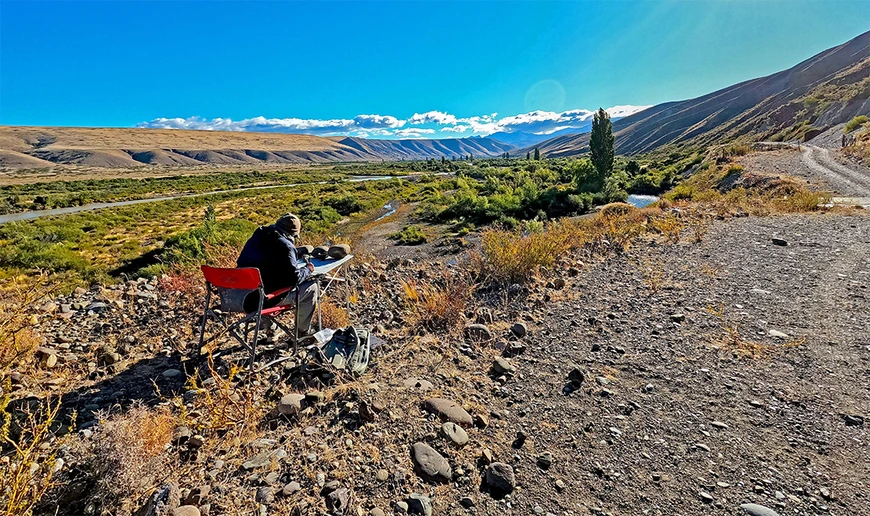

Alberto Rey drawing at the top of El Castillo (photo by TheBirdFilming.com).
Register now for fall open house: November 8


Alberto Rey drawing at the top of El Castillo (photo by TheBirdFilming.com).
Works by a SUNY distinguished professor emeritus will be on display in the Marion Art Gallery starting Sept. 5.
“ATLAS: Historical Works and Recent Journeys of Alberto Rey” will open with a reception from 6 to 9 p.m. on Sept. 5 at the gallery.
Professor Rey taught at Fredonia from 1989 until 2022 and was promoted to SUNY Distinguished Professor in 2007.
The exhibition includes133 paintings, drawings, and ceramics created by Rey during and after a recent five-month expedition to 14 countries and 22 UNESCO World Heritage Sites, together with pivotal works from past series. The exhibition also includes journal entries in paint books and sketchbooks, and art supplies used during the voyage. It runs through Nov. 21.
Rey will talk about his recent voyage and his artwork during a Visiting Artist Program lecture on Friday, Sept. 26, at 4 p.m. in McEwen Hall Room 209 and at an informal gallery talk during Homecoming Weekend on Saturday, Oct. 25 at 1 p.m., in the Cathy and Jesse Marion Art Gallery.
The exhibition, lecture, gallery talk, and reception are free and open to the public.
Marion Art Gallery Director Barbara Räcker said “ATLAS: Historical Works and Recent Journeys by Alberto Rey’ begins with 11 paintings, drawings and ceramics, dating from 1992 to 2022, that represent seven important past series — ‘Binary Forms,’ ‘Las Balsas,’ ‘Appropriated Memories,’ ‘Lost Beauty: Icebergs,’ ‘Extinct Birds,’ ‘Critically Endangered Palms of Cuba’ and ‘Biological Regionalism.’
Rey notes many of the series are interconnected.
“The ‘Critically Endangered Palms of Cuba’ series documents the critically endangered palm species that are native only to Cuba and which are on the verge of extinction,” he said. “Perhaps it is because I reside in western New York which is far from the island where I was born, but I am still enamored and nostalgic with the image of the solitary palm tree. I see this work as an extension of my emotional connection to the flora and fauna investigated in the ‘Biological Regionalism’ series, the ‘Extinct Birds’ project, and ‘Lost Beauty’ series.”
Räcker said the voyage drawings and paintings are divided into 16 sections according to the location and order of the trip — the Galápagos Islands, Chile, Argentina, New Zealand, Fiji, Australia, Tasmania, Singapore, Japan, Spain, Morocco, Italy, Slovenia, Switzerland and France. During the 2024 trip, Rey continued his exploration of flora, fauna, and diverse cultures.
Like the palms of Cuba, Rey became fascinated with the cacti of the Galápagos Islands writing, “The Prickly Pear Cacti, Opuntia galapageia, was first recorded by Charles Darwin in 1835. There are different variations of this cacti that are endemic to each of the islands. I fell in love with these cacti as I have with palm trees in Cuba. They reminded me of solitary souls bearing witness to the changes that happen on the islands as generations of inhabitants and visitors come and go.”
Of the ancient indigenous people in Argentina and Chile, Rey writes, “The Selk’nam tribe in Patagonia survived the harsh environment of southern Patagonia for 10,000 years until they were hunted down by European sheep herders, farmers and bounty hunters during the 19th century. The remaining members of the tribe, like others across the world who were not killed or had not died from disease, were forced to assimilate to Western culture and many of their children were placed in Christian missions.” Three paintings of Selk’nam sculpture are included in the exhibition.
On a lighter note, Rey explained the two Godzilla drawings in the Japan section of the exhibition have roots in his childhood.
“This is the version of Godzilla that I remembered from when I was a young boy in the late 1960s,” he said. “I fondly remember going to Barnesboro in Pennsylvania to our local movie theater and watching these eagerly anticipated movies. I never expected that I would travel to Tokyo to where these movies were filmed.”
During his time teaching at Fredonia, Rey earned the SUNY Chancellor’s Research Recognition Award, the SUNY Chancellor’s Award for Excellence in Scholarship and Creative Activity, was named a Robert W. Kasling Lecturer and received the William T. Hagan Young Scholar/Artist Award.
Among the museums and galleries that include Rey’s artwork in their permanent collection are: Buffalo AKG Art Museum, Bronx Museum of the Arts, Brooklyn Museum, Centro de Arte Contemporáneo de Caja de Burgos, Burgos, Spain; El Museo del Barrio, New York, NY; Frost Art Museum, Florida International University, Miami, FL; Lowe Art Museum, University of Miami, FL; Museo Extremeño e Iberoamericano de Arte Contemporáneo (MEIAC), Badajoz, Spain; Peabody-Essex Museum, Salem, MA, and Tampa Museum of Art, Tampa, FL.
Rey is the founder and director of a youth fly fishing program that, since 1994, meets weekly. He has been a fly-fishing guide for 24 years and in 2021 was named the Orvis Fly Fishing Guide of the Year.
“ATLAS: Historical Works & Recent Journeys by Alberto Rey” is supported by the Fredonia College Foundation’s Cathy and Jesse Marion Endowment Fund, as well as the Friends of Rockefeller Arts Center.
Gallery hours are Tuesday through Thursday from noon to 4 p.m., Friday and Saturday from noon to 6 p.m.; Sunday from noon to 4 p.m.; and by appointment. The Marion Art Gallery is located on the main level of Rockefeller Arts Center on Fredonia campus.
A 150-page complimentary exhibition catalog, designed by Matt Mateosian, includes an essay by Dr. Jamie DiSarno, diary entries by Rey, 93 images of artwork in the exhibition, an exhibition checklist, and photographs from the journey; it is available at the gallery or by request.
For more information about the exhibition or to schedule a free group tour, contact Räcker at barbara.racker@fredonia.edu or call (716) 673-4897.